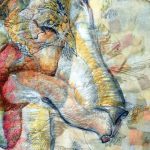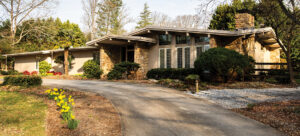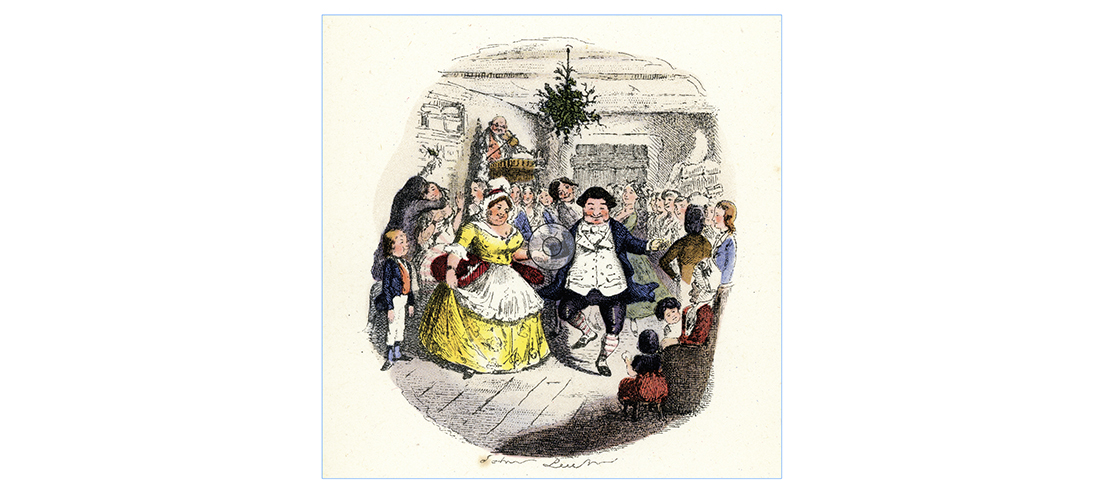
Five locals embody the true spirit of giving
By Jim Dodson
In A Christmas Carol, the beloved novella of greed and redemption published by Charles Dickens in 1843, the character of Nigel Fezziwig serves as a reminder of Ebenezer Scrooge’s forgotten youth, representing a time of innocence before Scrooge was infected with a money-making avarice that overwhelmed and tainted everything it touched in his life.
As the generous, big-hearted London businessman celebrating the arrival of Christmas by inviting people from every corner of society to share in the joy of food and dance, Old Fezziwig becomes an enduring symbol of the spirit of the holiday — one of sharing, caring, giving and believing in the goodness of humanity.
“The happiness he gives,” writes Dickens, “is quite as great as if it cost a fortune.”
Fezziwig, in short, is the true spirit of secular Christmas.
If we’re lucky, we’ve all known someone just like him. Look around with open eyes and you might be surprised how many Fezziwigs there are among us.
Cooper Dunning
The Spirit of Spreading Light
Photograph by Lynn Donovan
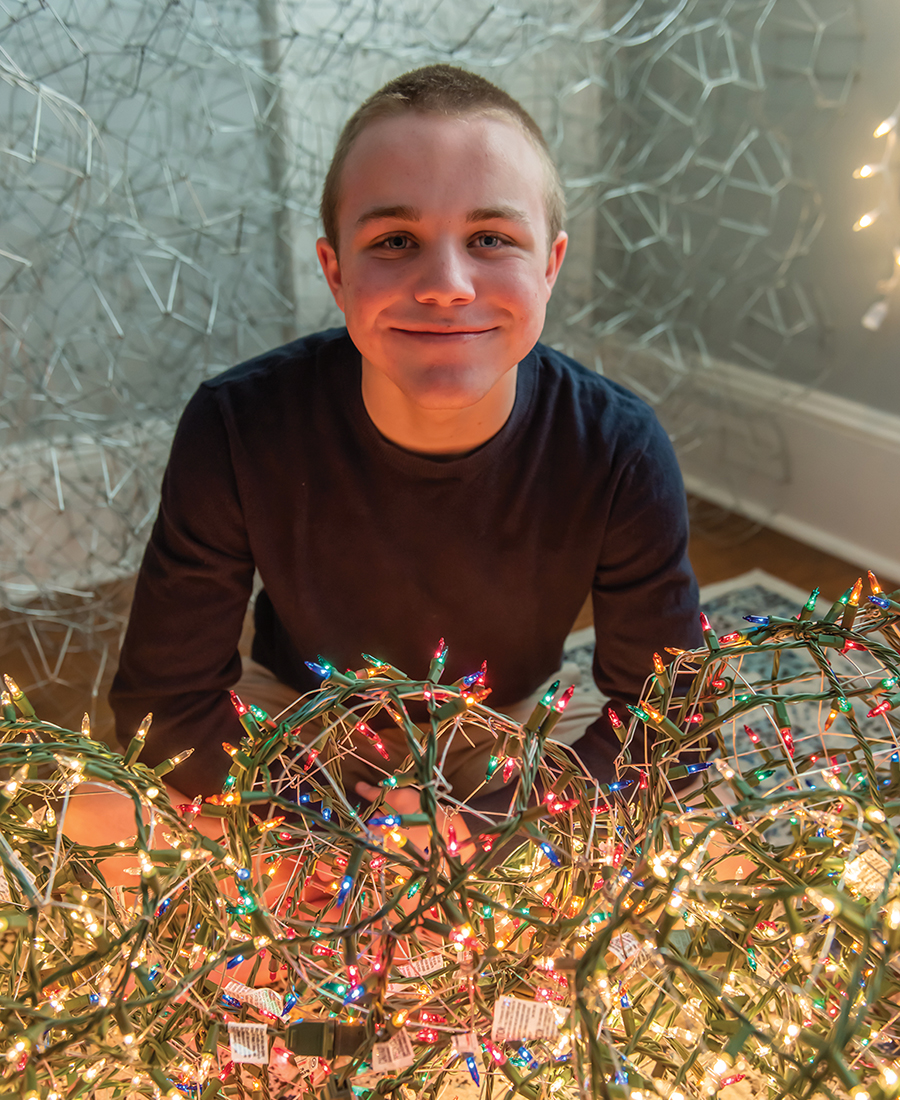 Cooper Dunning is one of those bright young folks who gives you hope that America’s future might be in good hands after all. When you mention the spirit of Nigel Fezziwig, the Grimsley freshman lights up like the famous twinkling Christmas balls that illuminate the trees of Sunset Hills every Christmas — which, as it happens, Coop probably knows more about than anyone.
Cooper Dunning is one of those bright young folks who gives you hope that America’s future might be in good hands after all. When you mention the spirit of Nigel Fezziwig, the Grimsley freshman lights up like the famous twinkling Christmas balls that illuminate the trees of Sunset Hills every Christmas — which, as it happens, Coop probably knows more about than anyone.
When he was just 9 years old, the enterprising youngster played Tiny Tim in a High Point Community Theater production of A Christmas Carol. “It was so much fun,” he reports. “And the story really gets you thinking about others.” About that same time, Coop became so fascinated with the lighted balls that annually transform Sunset Hills into a glowing and magical forest during the holiday season, he decided to start making his own.
“We already had 40 or 50 of them in our own yard,” he points out, which he and his father, Matt Dunning, who owns a Greensboro landscaping business, made together. “But I discovered there was a lot of demand for them from people in the neighborhood who wanted their own. I thought there might be a small business opportunity in making them to sell — and a chance to do some good with the profits.”
His entrepreneurial instincts proved to be sharper than Jacob Marley’s pangs of regret. That first Christmas season Cooper produced 50 lighted balls and sold them all through Sunset Hills’ popular Corner Farmers Market, which included a plan to donate 20 percent of sales to the market’s innovative Greens for Greens program, which assists lower income shoppers. That first year, he cleared enough to donate $150 to the program, including a canned food drive that benefited the Second Harvest food bank.
The next year — during the shut-down days we’d all like to forget — he was up to 700 lighted balls that netted $1,000 for Greens for Greens and Greensboro Urban Ministry. Last year, his sales ballooned to 800 multicolored lighted balls and a holly jolly $2,000 for his chosen charities.
True to his mission of spreading light and feeding neighbors, this year the young business prodigy — now a worldly 14 — is aiming to make and sell 1,000 lighted balls, hoping to boost his annual donation to help others to $3,000.
“That’s why my bedroom is kind of crowded right now,” he admits as his seven-week production run-up to the holidays got under way back in middle October. One factor that makes Cooper’s lights so popular is the thick-gauge, high quality fencing wire he uses instead of traditional chicken wire to fashion the balls. In his bedroom off South Elam Street this particular day, half of an interior wall is covered by finished wire balls — he refers to them as “shells” — ready for lighting. At the foot of his bed and filling a bedroom closet are hundreds of boxes of holiday lights, in all colors. “I just made a run to Lowe’s and pretty well cleaned them out,” he says with a laugh.
“We do have a bit of a storage issue,” admits his mom, Sarah, a communications professor at UNCG, poking her head into her son’s remarkably well-organized bedroom. “But he loves what he does and seems to get so much out of it.”
On average, Cooper can make 41 shells in about six hours, followed by another six hours of “wrapping” the balls with lights. “I’ve gotten much better at it,” he says, “and developed a system that works pretty smoothly. It helps that my forearms have gotten stronger over the years.” The added muscle, he explains, comes from playing tennis, swimming and rock climbing with friends.
One wonders when this young Fezziwig finds time to sleep, for he also produces a quarterly magazine that features the works of budding Gate City photographers and hosts a digital platform for their works. On the day O.Henry dropped by to see how production was going, he was preparing to dye his hair pink for Grimsley’s Friday night football game against Western Guilford — “It’s pink-out night this week,” he cheerfully explains. Coop’s older brother, Tobyn, plays linebacker for the Whirlies.
For the moment at least, this grown-up Tiny Tim has no immediate plans beyond looking forward to driver’s training class, growing his photography skills and continuing to bring a little more light to a darkened world by feeding others. “I’ve got time to figure out what comes next,” he says, sounding much wiser than his years. “In the meantime, this is something I love to do. It really makes people happy. Isn’t that the message of A Christmas Carol?”
Spoken like a true Fezziwig.
Andrew Levitt
The Spirit of Spreading Laughter
Photograph by Bert VanderVeen
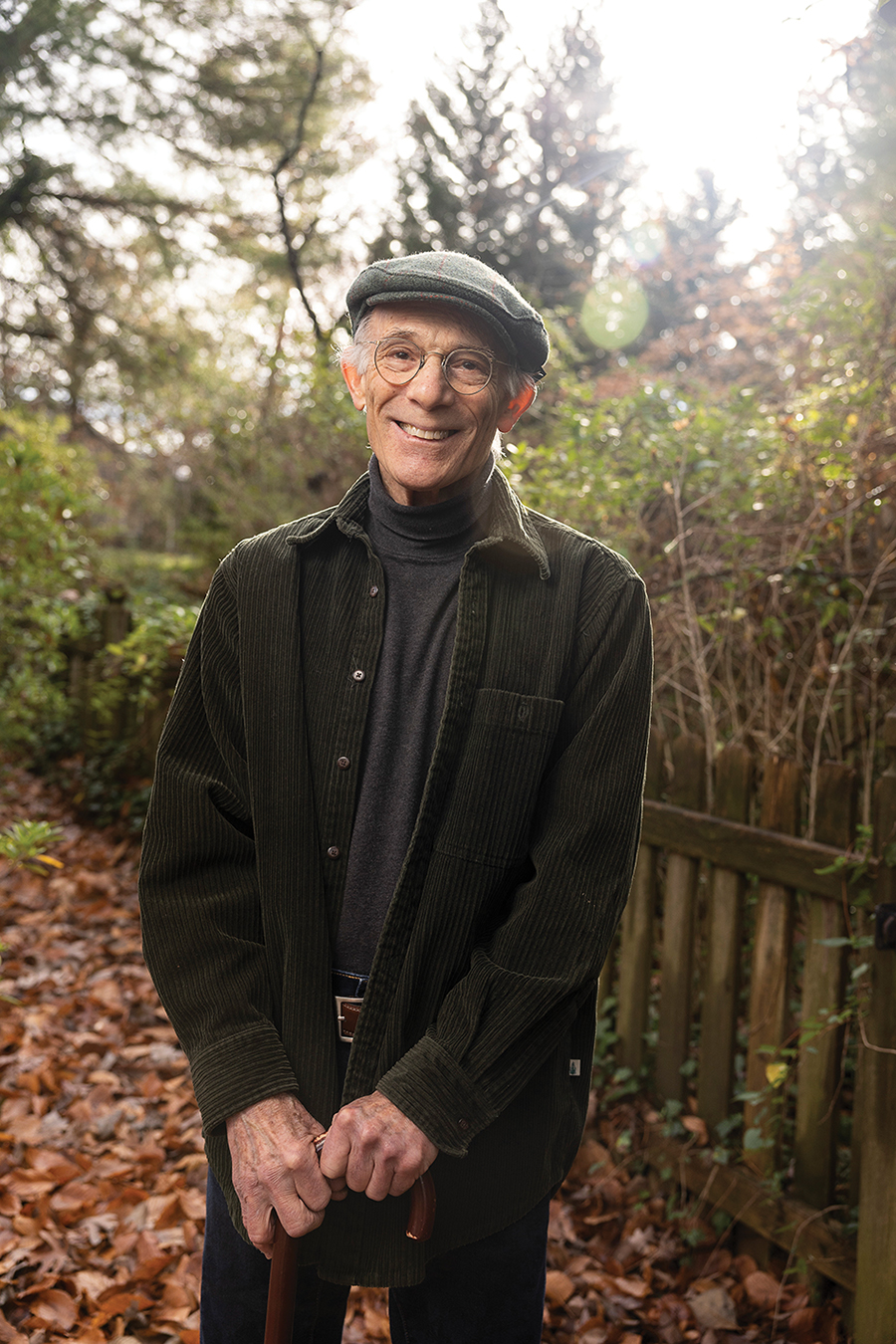
Andrew Levitt is one of those quiet souls who surprise you by the scope of their life and vision. Raised in a prominent Long Island family of sailors, early on he pictured a romantic life of racing sailboats to the West Indies — “In other words, your basic sailing bum,” he says with a laugh. “Fortunately, the universe had other plans for me.”
Indeed it did. After studying English literature at Yale, he became a Civil Rights activist who attended M.L. Kings’ funeral in Atlanta, joined the Peace Corps to teach school in Southeast Asia, and earned a Ph.d. in folklore from the University of Pennsylvania, where he met his wife, Peggy. He also became a gifted professional mime and nationally respected theater and live-performance educator, as well as an English teacher and published author and poet, not to mention a close friend of the late environmentalist — and Greensboro native — Thomas Berry. In tribute to his late mentor, Andrew wrote and performed a one-man show at the Greensboro History Museum based on the writings of his friend, dazzling an audience that included Berry’s brother, Leo, with his ability to replicate his hero’s voice.
Today, Andrew’s wife, Peggy Whalen-Levitt, is the director of the Center for Education, Imagination and the Natural World, a resource for teaching a new vision of the relationship between the inner life of the child and the beauty, wonder and intimacy of the universe. It’s these sacred values of life and nature that infuse every word of Andrew’s latest book, Heron Mornings, published in 2017, a poetic diary of one man’s moments of communion with the natural world while he walked his dog, Sasha, in the hours before dawn. “We’re all children of the forest,” he likes to point out, invoking one of Thomas Berry’s favorite sayings.
It was during one of our own predawn morning walks with the dogs several years ago that my wife and I met this remarkable fellow and his handsome samoyed, Misha, making their daily stroll through the neighborhood. As neighbors tend to do, brief greetings became casual conversations that eventually revealed this gifted poet and philosopher-naturalist in our midst.
During one of his own early walks years ago with Sasha — Andrew was teaching freshman English at Guilford at the time — he fell into conversation with a neighbor named Ernie Schiller who worked as a pediatric physician at Moses Cone Hospital. “I mentioned that many years ago my sister, who owns a successful art gallery in New York, put on a show that focused on medical clowns the Big Apple trains to work in area hospitals. It struck me that it might be fun to try do something like that around here — maybe at Duke University Hospital.”
“Good idea,” Schiller told him. “But you’re not going to Duke. You’re coming to Moses Cone!”
Fueled by his passion for narrative storytelling and live performance, a star with a big red rubber nose was born.
His first gig in April 2010 involved three days in the pediatric emergency department at Cone, which quickly turned into seven days a week. “I’d never seen the Patch Adams movie, but I basically made up my own repertoire of characters, a chimney sweep who sweeps away illness, a baker who bakes the pain away, no scary clown makeup — just a doctor with a funny red nose who comes in and announces, ‘I’m the doctor who treats your ills / With tales and folly instead of pills.’ I brought puppets and props. It made the kids laugh — even the parents and the real physicians.” Eventually, his colorful characters even found their way into a book.
“Andrew was a great person to have in the Children’s ED,” says Dr. Ross Kuhner, medical director of the children’s emergency department at Cone. “He helped ease the family and patient’s anxiety, and was always friendly and trying to be helpful. He had a wonderful disposition, always cheerful. I always felt bad about interrupting his puppet shows with the patients, and often watched along with the families.”
 “Our clown was wonderful,” agrees Registered Nurse Deedee Jamison. “He came to the Peds ED every day he was in the hospital. Children giggled and he played with his puppets. He was a friend who took time to care for each of us. He remembered my children and he made sure he took extra care to everyone who needed a smile. I loved him! Different bow ties for each day. . . . He was wonderful. . . . brilliant.”
“Our clown was wonderful,” agrees Registered Nurse Deedee Jamison. “He came to the Peds ED every day he was in the hospital. Children giggled and he played with his puppets. He was a friend who took time to care for each of us. He remembered my children and he made sure he took extra care to everyone who needed a smile. I loved him! Different bow ties for each day. . . . He was wonderful. . . . brilliant.”
Andrew Levitt’s charming medical clowning lasted almost a decade, touching the lives and cheering up thousands of kids, young people, parents and staff. It took the arrival of a worldwide pandemic to finally close down the show.
“I still think about the kids I met and entertained,” he says not long ago, during a walk around his block. “When I started out, I had no clue how to help a child who was on an IV or was suffering. But — you know? — it came to me. All my training helped. I would wave a light shield around my young patients — protecting them from worry and harm. Can you imagine that?”
Happily, we can.
Joe Campbell
The Spirit of Serving Others
Photograph by Bert VanderVeen
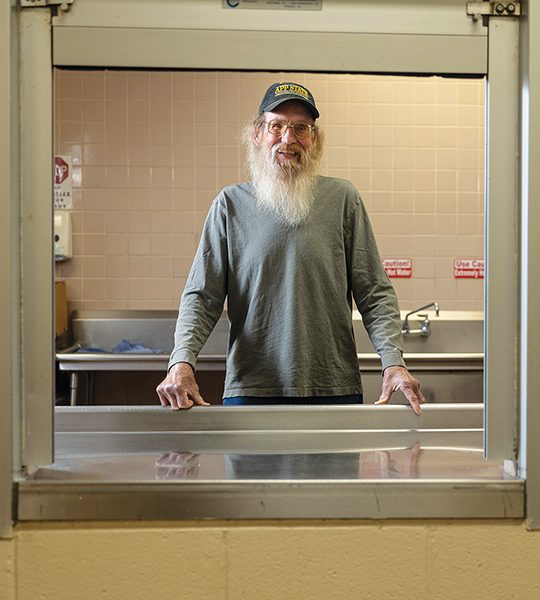 Joe Campbell is one of those folks you probably will never meet — until you need him.
Joe Campbell is one of those folks you probably will never meet — until you need him.
For many years he’s been a mainstay and volunteer at Greensboro’s Urban Ministry, serving warm meals and the wisdom of one who has been there and back to those who have fallen between the cracks of life.
A Greensboro native and self-described child of the ’70s, Joe took himself off to college and adopted a lifestyle of drugs and alcohol that led him to a place he never imagined going. “It was such a sad lifestyle,” he explains one chilly autumn morning over breakfast with a friend. “I drifted into it and met people who led me deeper into a lifestyle that had no value to anyone, including me. I had to finally reach the bottom. That’s when I found the way out.”
At his low point in 1979, he was consuming a case of beer daily and working at a curb market on Lawndale Drive. “One night this fella comes in and we start talking. He said some things about the power of God to change and heal that struck a strong chord with me — just a few words that changed my life. A few days later, he came by my house and we had a deeper conversation about the Holy Spirit and he posed a simple question to me: In a perfect world, what would I eliminate? I told him I would end lying and cheating and stealing — so that nobody would ever have to lock their doors at night.”
The stranger invited Joe to pray with him. It was his Road to Damascus experience.
“I got things off my back that night I’d been carrying for a very long time,” he explains. “I turned my back on them and walked with him to the Lord.”
Joe looks up and smiles, a trim, gray-bearded man who looks like a cross between Santa Claus and the patriarch of Duck Dynasty.
“I made a promise to God that night to give up alcohol, to pray, read my Bible and go with Jesus. The things I’d been doing in the past suddenly melted away. I never touched alcohol again. That was 43 years ago. In more ways than one, I was saved.”
He never learned the stranger’s full name. “His name was Don. Just Don. He wouldn’t even tell me where he went to church, said it didn’t matter. Just never go back to my old haunts, read and pray and tell others what happened to me. I never saw him again.”
Rather like Scrooge, as the result of the nighttime visitation, Joe was a changed man.
He found his salvation in following Jesus while selling antiques and working in lawn service. Over decades, he has helped others find their way back to the light of a good and sacred life. Best of all, he is part of a rotating team of dedicated Urban Ministry volunteers who provide food, shelter and spiritual wisdom to thousands of our neighbors in need each year. This means the world to Joe Campbell.
“Each of us has a different story,” he explains. “Mistakes and misfortune occur in every life. When I give my five-minute meditations, I like to share my own experience of finding a new life through faith and the gift of service to the Lord and others.”
The holidays always remind Joe of the gift he’s been given, especially at Christmas. He and wife, Marie, will welcome 30 family members to the holiday table this year. “That’s six children, 12 grandchildren and six great grandchildren,” he says with a twinkle. “We sort of blend Thanksgiving and Christmas together.”
But one old habit endures. “I like to find gifts at Goodwill or even on the streets of the city, used things people place at the curb. It’s amazing what you can find if you open your eyes. Really beautiful things that people overlook or cast aside.”
He would know.
First Moravian Church
The Spirit of Love, Candlelight and Good Things to Eat
Photographs by Lynn Donovan
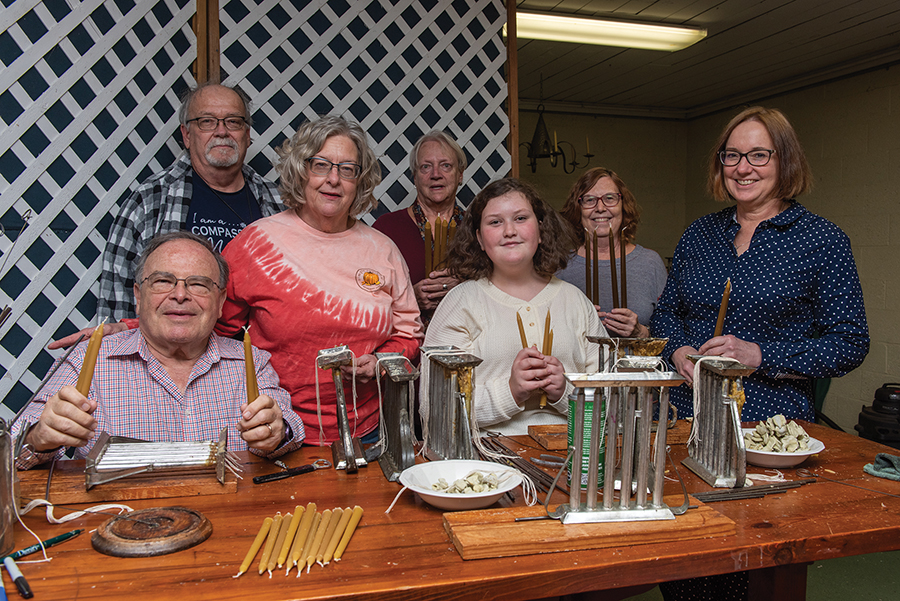
As a chilly late October evening settles over Lindley Park, the fright lights of Halloween are shining brightly across the neighborhood. Inside the cozy candle hut at First Moravian Church on Elam Avenue, however, just down the walk past the church’s new community garden, it’s the light of a holy infant’s birth in late December that illuminates the spirits of seven volunteers as they work.
“It’s like this every year, a true church-wide effort,” says volunteer candle stringer Beverly Lozano, who along with husband David — an assembler of plastic Moravian stars and a chicken pie specialist — have gathered on a Friday evening to make more than 1,500 beeswax candles by Christmas week. “Over the six or seven weeks before Christmas,” she says, “we’ll have anywhere from 40 to 50 members helping out. It’s a lot of work, but also a lot of fun — what the season is really all about for us. Sharing love and candlelight and good things to eat.”
First Moravian’s annual Candle Tea and Christmas Eve Candlelight Lovefeast are beloved traditions. They date back centuries in the world’s oldest continuing Protestant denomination. The services are a longtime holiday staple in the lives of thousands of Greensboro residents from all faith traditions who grew up attending the church’s annual candle tea and love feast as school kids, a practice that continues today.
In an increasingly commercialized world made all but inescapable by smart phones and roaming Amazon vans, there’s something about the simplicity of fragrant handmade beeswax candles, distinctive Moravian stars, delicious homemade chicken pies, sinfully sweet sugar cake, handmade crafts and simple advent wreaths that stirs fond memories of a slower time when waiting for Christmas was all about waiting for the birth of a child.
“Like many people, as a young adult,” confides Sam Post, a retired real estate attorney and longtime member, “I got caught up in all the holiday’s commercialism. But coming back here reminded our family of what the essence of Christmas is all about, literally bringing light and love into the world.”
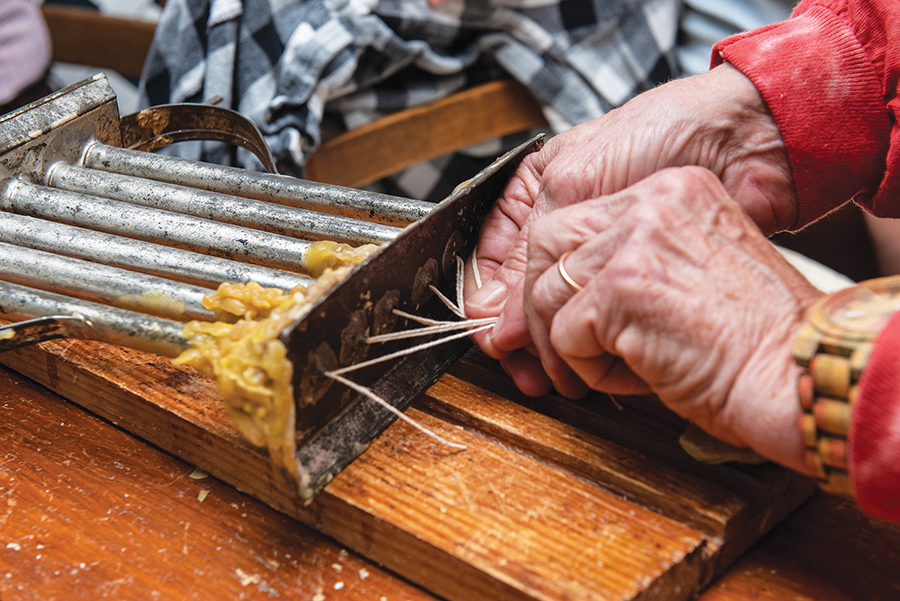
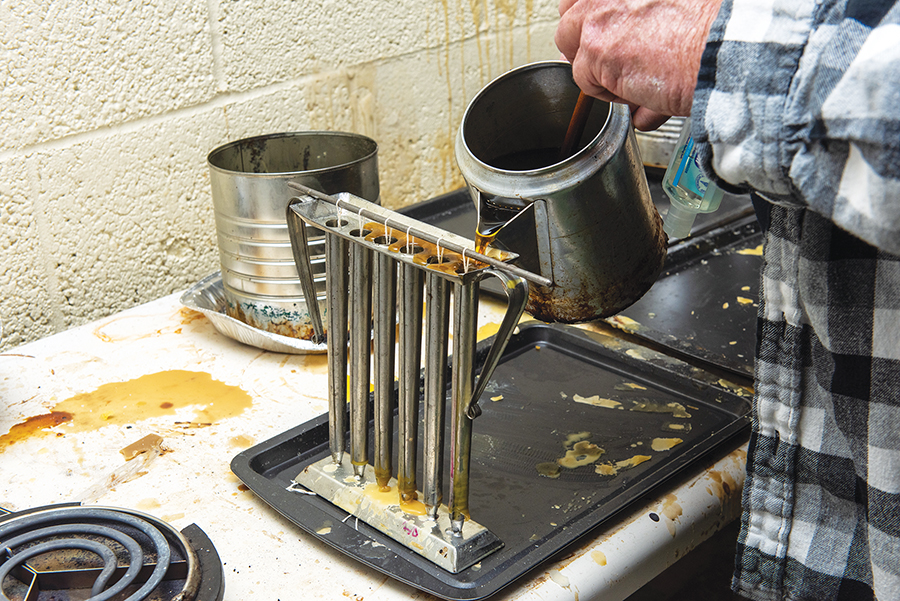
For many years, as a result, Post has served as something of the church’s de facto artisan-in-chief who makes the fragrant wax candles in vintage molds. He also creates spectacular paper stars and even builds sets for the candle tea’s annual “Putz,” German for “place,” a popular display that occupies the entire stage in the new fellowship hall with recreated scenes from Bethlehem, the Nativity, and an early Moravian village.
“The Putz simply wouldn’t happen without Sam and many others who give their talents to make the tea and lovefeast special every year,” allows volunteer Lisa Salo, who points out that early Moravians used such displays to illustrate Biblical stories for children and to share the spirit of the season with their neighbors.
Back in the candle hut, volunteer Addie Joplin, a UNCG international business major who will graduate in December, is busy stringing the candle molds before the wax is poured. “This is literally something that means so much to me because I grew up attending the candle teas and lovefeasts at my church up in Hickory [New Hope Moravian]. The light and scent of the candles on Christmas Eve is just about the most beautiful thing you’ll ever see.”
A few feet away, longtime volunteer Nancy Wall is trimming and polishing the candles with, of all things, women’s nylon stockings. “It’s one of our trade secrets,” she quips. “We give up our pantyhose to make the candles shine.” She jokes that she “married a Moravian and was forced into the church,” but wouldn’t have it any other way. This is her 25th year as a volunteer, she explains.
“We do this,” sums up Beverly Lozano, a Baptist-turned-Moravian who moved to Greensboro from New Jersey with David eight years ago, “because we consider it our gift to the community, whatever faith tradition people follow. It’s all about sharing love and candlelight, a beautiful tradition that’s passed down to us. It’s our joy to share it with everyone — and shine a light into the darkness.”
“Not to mention, our delicious chicken pie,” adds David Lozano, heading off to the kitchen where more than 1,500 pies are currently in production. “The men chop the chicken. The women make the dough. We think ours are the best you can find anywhere — the reason they sell out every year!”
For more information, contact greensboromoravian.org/ or phone (336) 272-2196.
Körner’s Folly
The Spirit of Surprise and Joy
Photograph by Lynn Donovan
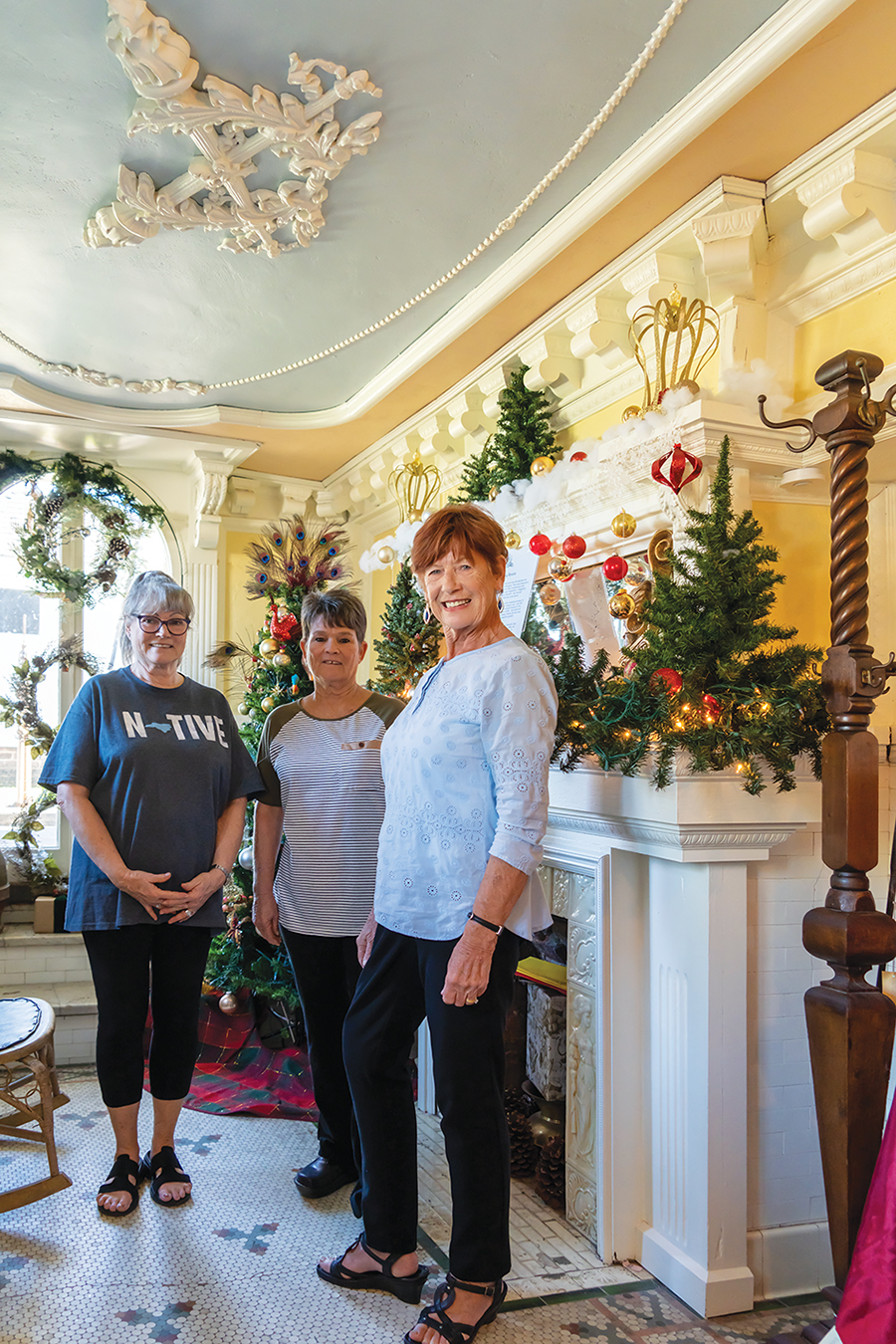 It may take a village to raise a child, as the familiar African proverb goes. But nothing less than a community of volunteer decorators is required to get historic Körner’s Folly in Kernersville annually decked out for its over-the-top Christmas display.
It may take a village to raise a child, as the familiar African proverb goes. But nothing less than a community of volunteer decorators is required to get historic Körner’s Folly in Kernersville annually decked out for its over-the-top Christmas display.
“The work begins around Halloween,” says Suzanna Ritz, “when a small army of folks from all over town devote their time and imagination to transforming this wonderful old house into something magical. Volunteers are the heart and soul of this incredible house.”
Eccentric Kernersville designer, artist and decorator Jule Gilmer Körner built his marvelously eclectic 5,600-square-foot, brick dreamhouse with its unique cross-gabled shingled roof in 1880, in part to promote his popular designs and custom furniture to potential customers — a classic Victorian “folly” that featured 27 rooms, 15 fireplaces, trap doors, a full theater, and no two doors or windows alike. Körner is best known as the marketing genius who created the national Bull Durham logo campaign that netted him a fortune.
Following Jule’s death in 1924, as Nancy Oakley, O.Henry’s once-senior editor, engagingly profiled in 2018, the impact of the Great Depression and two World Wars prompted the Körner family to board up the house, “which fell prey to vandals and looters. It became a haunt of local teenagers, some of whom carved their initials in one of the upstairs hallways. Even after the property’s purchase and protective placement on the National Register, the property was manned solely by volunteers for 30 years.”
In 1970, 26 local families — including Körner heirs — banded together to save the house from demolition, achieving protective status from the National Register of Historic Places three years later. A foundation was created to bring the house slowly back to life.
In the 1980s, family member Connie Körner not only directed the extensive renovation of the house/museum but inaugurated a lavish holiday decorating tradition in 2010 that echoes the Folly’s original Victorian splendor and seems to outdo itself every year. Hewing to a different Victorian theme each year, every room and nook of the house is lavishly decorated in period style by dozens of local volunteer decorators ranging from the local Boy Scout troop from the Moravian Church across the street to the Young Professionals Network from the Chamber of Commerce.
Over the past decade, the imaginative handiwork of longtime volunteers Ann Stoebe and Tim Burrow has come to define the kind of high-energy creativity that makes the decorated house a treasured holiday destination for more than 3,000 visitors annually during the holiday season.
Stoebe, 79, a native of Bedford, England, relies on her love of Christmas and cherished childhood memories to stir her creative juices. “You never quite know until you start where this will lead you,” she says. “But it’s really quite magical how it happens. I dream about decorations, even go to bed envisioning what I will do. For me, there’s so many wonderful memories of Christmas that are attached to this project.”
Famous for her bright red plaid ribbons and decidedly English touches, Stoebe has decorated a score of the house’s more eccentric rooms, including the tidy “Rose” room she did some years back with help from her daughter, Michelle, and granddaughter, Emma. This year, Stoebe’s assigned space is the cozy “Smoke Room,” which she aims to transform into an “Orient Express” theme using vintage leather suitcases, walking canes, Homburg hats, German humidors and an electric fireplace.
“I tried to give all of this up three years ago when my husband and I downsized our own house big time and got rid of a lot of my props,” she adds with a laugh. “But every year they say please and I come back. I just love it!”
She playfully points a finger at Tim Burrow. “Fortunately, Tim has a house full of props for any theme you can think of. He’s the source of true Christmas magic.”
Burrow is a resident of Asheboro who works with an estate sale company. “The entire second floor of my house is filled with nothing but props and decorations,” he explains, including all kinds of artificial trees and greenery. “You name it, I’ve probably got it.” In recent years, his portfolio of uber-festive rooms has included an upside down Christmas Tree with Victorian China tea cups, and trees covered with vintage postcards and Victoran musical instruments.
Since 2022’s theme is “A Storybook Christmas,” Burrow is turning the house’s library into a workshop for elves and a shoemaker, using 50 marionettes and puppets. Visitors will also find one of his vintage sleighs sitting on the lawn outside for use in holiday family photographs. He loves to dress in period costumes and visit with guests as they walk through rooms on the tours, including once as the ghost of Jacob Marley.
“I love to chat with visitors just to see their faces when they see what we’ve done to these rooms. It never fails. Their faces truly light up with joy. That’s what Christmas is all about – surprise and joy. That makes all our work such a pleasure.” OH
Körner’s Folly’s popular Candlelight Tours are scheduled for December 3 and 17, featuring carolers, costumed guides, hot cider and Moravian cookies. Information: kornersfolly.org or (336) 996-7922.

